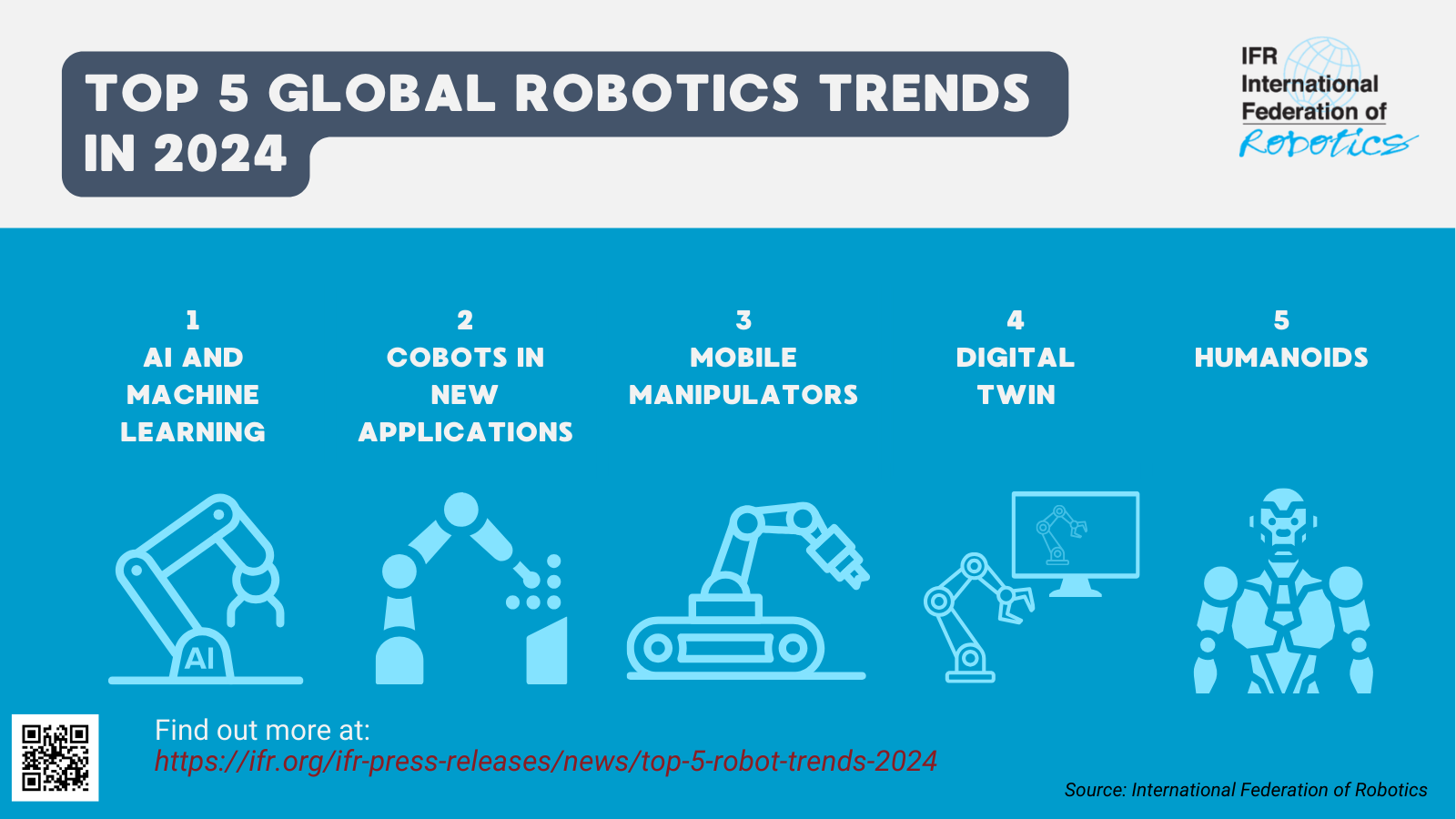Delving into the realm of robotics and automation trends, we uncover the latest advancements and transformative impact of these technologies across various industries. From cutting-edge applications to technological innovations, this narrative promises to provide a captivating insight into the world of automation.
As we navigate through the intricate landscape of robotics and automation trends, we aim to shed light on the critical aspects that shape the future of work and sustainability in this evolving technological era.
Current Robotics and Automation Trends

Robotics and automation technologies are rapidly evolving, paving the way for exciting advancements across various industries. Let's dive into some of the latest trends shaping the landscape of robotics and automation.
AI-Powered Robotics
AI-powered robotics is revolutionizing automation by enabling machines to learn from experience, adapt to new situations, and make decisions without human intervention. This trend is enhancing efficiency and productivity in industries such as manufacturing, healthcare, and logistics.
Collaborative Robots (Cobots)
Collaborative robots, or cobots, are designed to work alongside humans in a shared workspace. These robots are equipped with advanced sensors and safety features, making them safe and easy to interact with. Cobots are increasingly being used in tasks that require human-robot collaboration, such as assembly lines and warehouses.
Autonomous Vehicles
The development of autonomous vehicles, including self-driving cars and drones, is a major trend in robotics and automation. These vehicles rely on AI algorithms and sensors to navigate and make decisions on the road or in the air. The deployment of autonomous vehicles is reshaping transportation, delivery services, and urban planning.
Internet of Things (IoT) Integration
The integration of robotics and automation with the Internet of Things (IoT) is enabling seamless communication and coordination between devices and systems. This trend is enhancing the efficiency of smart factories, homes, and cities by connecting robots and automated systems to a networked environment.
3D Printing and Additive Manufacturing
D printing and additive manufacturing technologies are transforming the production process by enabling the creation of complex geometries and customized products. Robotics and automation are increasingly being integrated into 3D printing systems to enhance precision, speed, and scalability.
Robot as a Service (RaaS)
Robot as a Service (RaaS) is a growing trend where companies offer robots on a subscription or pay-per-use basis. This model allows businesses to access advanced robotics solutions without the need for large upfront investments. RaaS is making robotics more accessible to a wider range of industries and applications.
Impact on Labor and Workforce
As robotics and automation continue to advance, they are significantly impacting job opportunities and the overall workforce. The integration of robots in various industries brings both benefits and challenges that need to be carefully considered.
Job Opportunities and Automation
With the rise of robotics and automation, certain job roles are becoming automated, leading to a shift in labor requirements. Routine tasks that are easily replicable by machines are being taken over by robots, potentially reducing the need for human workers in those specific areas.
Role of Upskilling and Reskilling
In the age of automation, upskilling and reskilling play a crucial role in ensuring that the workforce remains relevant and adaptable. Workers need to acquire new skills that complement automation technologies, allowing them to take on roles that require human creativity, critical thinking, and problem-solving abilities.
Benefits and Challenges of Integrating Robots
Integrating robots in the workforce can lead to increased efficiency, productivity, and accuracy in tasks. However, this shift also poses challenges such as potential job displacement, the need for retraining programs, and the adaptation of workplace dynamics to accommodate human-robot collaboration.
Technological Innovations
Artificial intelligence (AI), Internet of Things (IoT), and machine learning are driving significant advancements in the field of robotics and automation. These technologies are reshaping industries, enhancing efficiency, and transforming the way tasks are performed.
Role of Artificial Intelligence in Enhancing Robotics and Automation
Artificial intelligence plays a crucial role in enhancing robotics by enabling machines to learn from experience, adapt to new inputs, and perform tasks that traditionally required human intelligence. AI-powered robots can analyze data, make decisions, and execute complex tasks with precision and speed.
For example, in manufacturing, AI algorithms are used to optimize production processes, detect defects in real-time, and enhance quality control
Significance of Internet of Things (IoT) in Smart Automation Systems
The Internet of Things (IoT) is revolutionizing automation systems by connecting devices, sensors, and machines to the internet, allowing them to communicate and share data in real-time. IoT enables seamless integration and coordination of various components in automated systems, leading to improved efficiency, productivity, and decision-making.
For instance, in smart homes, IoT technology enables remote monitoring and control of appliances, lighting, and security systems through a centralized platform.
Machine Learning Revolutionizing Robotics
Machine learning is transforming robotics by enabling machines to improve performance autonomously through continuous learning from data and experience. Machine learning algorithms allow robots to adapt to changing environments, optimize processes, and make predictions based on patterns and trends. For example, in autonomous vehicles, machine learning is used for image recognition, object detection, and decision-making to navigate roads safely and efficiently.
Sustainability and Environmental Impact

Robotics and automation play a significant role in promoting sustainability and reducing environmental impact in various industries. These technologies offer numerous benefits that contribute to more eco-friendly practices and resource conservation.
Reduced Energy Consumption
- Automated systems are designed to optimize energy usage, leading to reduced overall consumption compared to manual operations.
- Robots can perform tasks with high precision and efficiency, minimizing wastage and unnecessary energy expenditure.
- By streamlining processes, automation helps in lowering energy costs and carbon emissions, making operations more sustainable.
Waste Reduction and Recycling
- Robotics enable better waste management through sorting, recycling, and processing materials, promoting a circular economy.
- Automated systems can identify and separate recyclable materials more efficiently than manual labor, enhancing recycling rates.
- Reducing waste generation and maximizing resource utilization are key factors in improving environmental sustainability.
Challenges in Sustainability
- Initial investment costs for implementing robotics and automation systems can be high, posing a barrier for smaller businesses looking to adopt sustainable practices.
- Technological advancements may lead to electronic waste concerns as outdated equipment is replaced, requiring proper disposal and recycling methods.
- Ensuring the sustainability of automated systems throughout their lifecycle, including energy consumption and material usage, presents ongoing challenges that require careful monitoring and management.
Final Wrap-Up

In conclusion, the dynamic landscape of robotics and automation trends offers a glimpse into the promising advancements and potential challenges that lie ahead. As we embrace the era of automation, it is essential to navigate these trends with a strategic vision for a sustainable and efficient future.
FAQ Resource
How are robotics and automation technologies transforming industries?
Robotics and automation technologies are revolutionizing industries by streamlining processes, increasing efficiency, and enabling new possibilities for automation and data-driven decision-making.
What is the impact of robotics and automation on job opportunities?
While robotics and automation may replace certain repetitive tasks, they also create new job opportunities in areas such as robotics maintenance, programming, and system integration. Upskilling and reskilling programs play a crucial role in preparing the workforce for these emerging roles.
How do robotics and automation contribute to sustainable practices?
Robotics and automation contribute to sustainability by optimizing energy consumption, reducing waste, and enhancing overall efficiency in processes. By implementing automated systems, businesses can minimize their environmental footprint and operate in a more eco-friendly manner.
What role does artificial intelligence play in enhancing robotics and automation?
Artificial intelligence enhances robotics and automation by enabling machines to learn from data, make decisions, and perform tasks with human-like intelligence. This integration of AI capabilities enhances the efficiency and adaptability of automated systems.



